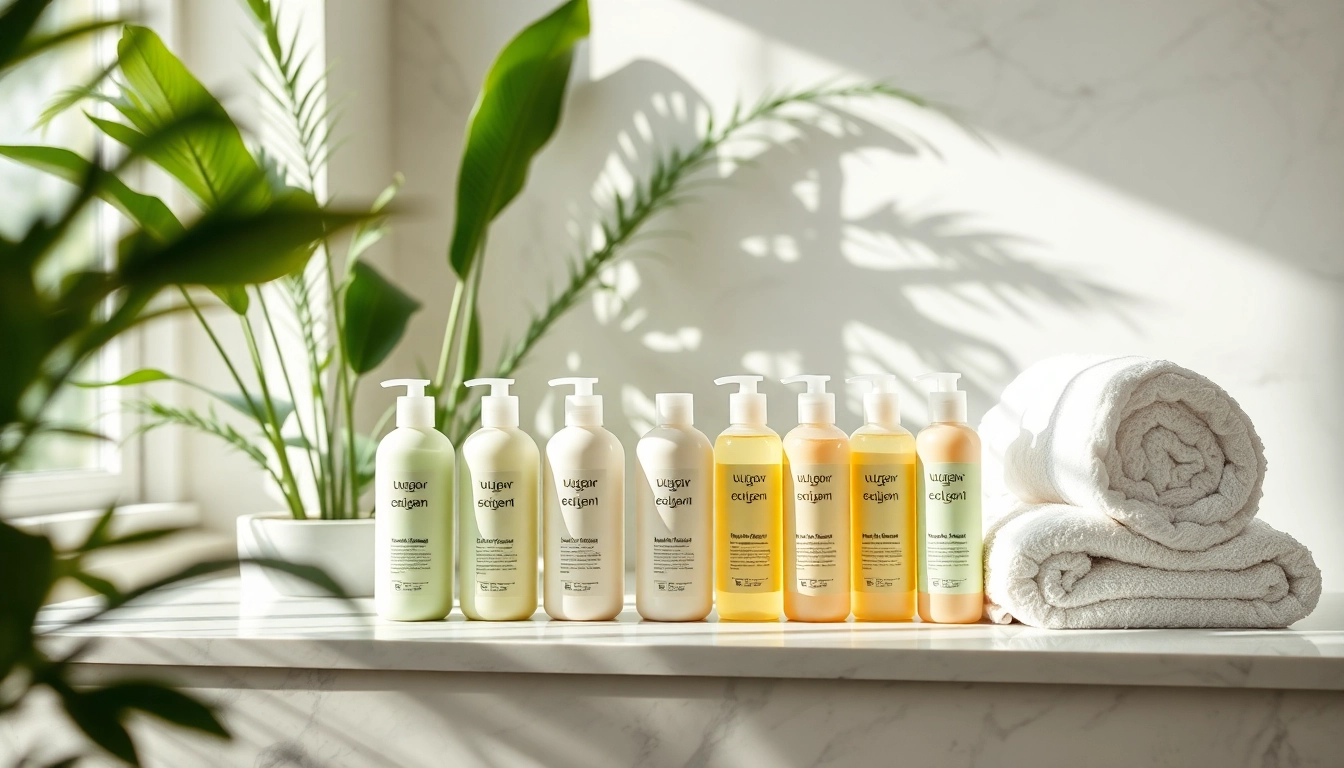Understanding Sulfate Free Shampoo
What is Sulfate Free Shampoo?
Sulfate free shampoo is a type of hair cleanser that does not contain sulfates, which are harsh detergents commonly found in many conventional shampoos. The most prevalent sulfates used in hair products include sodium lauryl sulfate (SLS) and sodium laureth sulfate (SLES). These ingredients are included primarily for their ability to create a rich lather, but they can also strip the hair of its natural oils, leading to dryness and irritation.
When you choose sulfate free shampoo, you’re opting for a gentler alternative that cleanses without removing essential moisture. This type of shampoo is ideal for individuals with sensitive skin, color-treated hair, or anyone looking to maintain healthy, hydrated locks.
Benefits of Using Sulfate Free Shampoo
The benefits of using sulfate free shampoo extend beyond just gentler cleansing. Some of the most noteworthy advantages include:
- Less Irritation: Sulfate-free formulas are much less likely to cause scalp irritation or allergic reactions, making them suitable for sensitive skin types.
- Maintained Natural Oils: These shampoos help retain your hair’s natural oils, promoting overall hair health and shine.
- Reduced Color Fading: For those with color-treated hair, sulfate free shampoos can help preserve color vibrancy, reducing the risk of fading due to chemical damage.
- Moisture Retention: The absence of sulfates means that the shampoo is less likely to dry out hair, making it an excellent choice for individuals with dry or frizzy hair.
- Improved Texture: Many users report that their hair feels softer and more manageable after switching to sulfate-free products.
How Sulfate-Free Formulations Work
Sulfate-free shampoos utilize alternative cleansing agents, such as cocamidopropyl betaine, decyl glucoside, or plant-based surfactants, to provide a milder wash. These ingredients effectively lift dirt and oil from the hair and scalp, all while preserving moisture. Additional ingredients such as essential oils, botanical extracts, and proteins can be included to enhance hair health, offering benefits like nourishment, protection, and shine.
Choosing the Right Sulfate Free Shampoo for Your Hair Type
Identifying Your Hair Type
Choosing the right sulfate free shampoo begins with knowing your hair type. Hair types can be categorized into four main types: straight, wavy, curly, and coily. Each type has different needs, and identifying your hair’s characteristics—like texture, porosity, and density—can guide you in selecting the right product.
- Straight Hair: Usually less prone to dryness; look for light conditioners that won’t weigh your hair down.
- Wavy Hair: Often frizz-prone; consider shampoos that help define waves while offering moisture and frizz control.
- Curly Hair: Needs hydration and bounce; look for shampoos with rich moisturizers and curl-enhancing ingredients.
- Coily Hair: Most susceptible to dryness; opt for shampoos with ultra-hydrating formulas that define coils while providing deep moisture.
Key Ingredients to Look For
When shopping for sulfate free shampoos, pay attention to the ingredient list. Here are some beneficial components to look for:
- Natural Oils: Ingredients like argan oil, jojoba oil, or coconut oil nourish and hydrate.
- Botanical Extracts: Aloe vera, chamomile, and green tea extracts provide soothing and conditioning properties.
- Proteins: Hydrolyzed silk, keratin, or rice protein can strengthen hair and improve manageability.
- Vitamins: B vitamins and vitamin E are great for promoting overall hair health.
Common Mistakes to Avoid
When transitioning to sulfate free shampoo, many people make common mistakes that can undermine the benefits:
- Not Using Enough Product: Sulfate-free shampoos may not foam as much; ensure you use enough product to cleanse your hair effectively.
- Washing Too Often: Avoid over-washing; it can strip hair of moisture. Two to three times per week is generally sufficient.
- Ignoring Conditioner: Always pair sulfate-free shampoo with a nourishing conditioner to help lock in moisture.
How to Transition to Sulfate Free Shampoo
Steps for a Smooth Transition
Transitioning to sulfate free shampoo might take some time for your hair and scalp to adjust. Here’s how to make the process smoother:
- Start Slowly: Begin by using sulfate free shampoo a few times a week while gradually reducing your use of regular shampoo.
- Check Ingredient Labels: Always read ingredient lists carefully to ensure that the product is truly sulfate free.
- Be Patient: Some users notice an initial increase in oiliness as the scalp adjusts to the new regimen.
What to Expect During the Transition
During the transition period, you may experience the following:
- Increased Oiliness: Your scalp may produce more oil initially as it adapts to sulfate-free products.
- Product Build-Up: Depending on your previous products, you may need a clarifying treatment to fully remove residue.
- Improved Texture Over Time: Most individuals eventually see softer, healthier hair as it adjusts to the lack of harsh sulfates.
Complementary Products for Best Results
To enhance the benefits of sulfate free shampoo, consider incorporating complementary products into your routine:
- Deep Conditioners: Weekly deep conditioning treatments can provide added moisture.
- Leave-In Conditioners: These can help manage frizz and hydrate throughout the day.
- Hair Oils: Natural oils can seal moisture and improve shine, especially for dry or curly hair types.
DIY and Natural Alternatives to Sulfate Free Shampoo
Homemade Sulfate Free Shampoo Recipes
If you prefer a more natural approach, making your own sulfate free shampoo can be a rewarding endeavor. Here are a couple of simple recipes:
Basic Coconut Milk Shampoo
Ingredients:
- 1 cup coconut milk
- 1/4 cup liquid castile soap
- Essential oils (optional for fragrance)
Instructions: Mix the ingredients in a bottle and shake well before each use. It gently cleanses while providing moisture.
Honey and Aloe Vera Shampoo
Ingredients:
- 1/4 cup aloe vera gel
- 1/4 cup honey
- 1/2 cup water
Instructions: Mix all ingredients and store in a bottle. This combination hydrates and nourishes the hair.
Benefits of Natural Ingredients
Natural ingredients in DIY shampoos can offer distinct advantages:
- Customizable: You can tailor your shampoo to meet your specific hair needs.
- Fewer Chemicals: Reducing chemical exposure can benefit scalp and hair health.
- Cost-Effective: Often cheaper than store-bought products in the long run.
Tips for Customizing Your Shampoo
Here are some ways to customize your homemade shampoo to maximize its benefits:
- Add Essential Oils: Oils like lavender and tea tree can add fragrance and offer additional benefits like soothing the scalp.
- Incorporate Herbal Infusions: Infuse your shampoo with herbs like rosemary or chamomile for enhanced hair benefits.
- Adjust Consistency: Alter the water-to-agents ratio for a thicker or thinner shampoo as preferred.
Performance and Results: Measuring Your Hair’s Health
How to Track Changes in Your Hair
To determine how well your hair is responding to sulfate free shampoo, keep the following in mind:
- Take Before and After Photos: Visually tracking your hair’s condition can highlight changes over time.
- Note Texture Changes: Pay attention to how your hair feels texture-wise after consistent use of sulfate-free products.
- Monitor Scalp Health: Look for reduced irritation or oiliness as signs of improved scalp health.
Understanding Hair Health Metrics
Understanding your hair health metrics provides insight into how well your hair is adapting to sulfate free shampoo:
- Moisture Levels: Determine if your hair feels hydrated vs. dry after transitioning.
- Shine: Increased shine generally indicates that hair is healthier and well-hydrated.
- Split Ends and Breakage: A decrease in these factors indicates improved hair health.
Long-Term Benefits of Switching to Sulfate Free
The long-term benefits of committing to sulfate free shampoo can be substantial. Users report:
- Healthier Hair: Improved texture and overall health after consistent use.
- Less Damage: Reduction in hair damage from environmental factors and heat styling.
- Increased Manageability: Smoother hair often leads to easier styling and less frizz.
- Financial Savings: With healthier hair, there may be less need for expensive treatments and deep conditioners.



